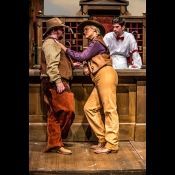Arizona Opera is making history this season when it becomes the first major American opera company to mount Emmerich Kálmán’s “Arizona Lady.”
It opens in Tucson this weekend before going to Phoenix next weekend, which seems apropos: The story takes place in Tucson.
The plot: Striking Hungarian immigrant Lona Farrell is buried in a mountain of debt left by her émigré father and is desperate to save her Sunshine Ranch in Tucson. It’s 1925 and there’s a sizable purse up for grabs at the Tucson rodeo — enough to pull her out of her financial distress. Problem is, she has no one to ride her prized filly Arizona Lady; she fired her best rider/ranch foreman after he tried to put the moves on her.
But along comes newcomer Roy Dexter, a Colorado cowboy who can ride. But the sheriff, Harry Sullivan, thinks Dexter’s a horse thief. He’s also smitten with Farrell and sees the handsome cowboy as competition.
Thus begins an oftentimes comic romp of marriage proposals, broken hearts, shattered dreams and an improbable fantasy that plays out at the grandest horse race of them all, the Kentucky Derby.
“ ‘Arizona Lady’ deals with a part of our history when immigrants were settling the lands and the beginning of identifying who we were in the Western culture,” said Arizona Opera general director Ryan Taylor, who programmed the piece as part of his “Arizona Bold” initiative to present regionally relevant works that resonate with Arizona audiences.
“We were adventurous people. We raised horses,” he said. “It’s a lot of fun getting to do a story about our backyard and not a story that takes place in wintery Russia or Milan or some fantastic adventure in German that takes place in time and space. This is here and it takes place in Arizona.”
The backstory: Conductor Kathleen Kelly teamed up with Arizona’s first poet laureate, Alberto Ríos, to translate the piece from Kálmán’s German to English and Spanish. It’s performed in all three languages with English supertitles.
Kálmán’s original piece had some 36 characters and stretched over four hours.
“I think a part of what the original composer was trying to do was bring a little bit of the American musical back to Europe with him, very specifically the musical ‘Oklahoma’,” Kelly said. “I think he was trying to introduce a lot of parts of American life from Oklahoma that seems really wild to him as a European, like the traveling salesperson and the whole idea of a carnival and a fortune teller. So it was kind of everything and the kitchen sink in the original. Which is great, except that the composer never actually oversaw a production of his own opera. He was already very, very ill by the time it premiered. He had had a stroke.”
Kálmán, who was known for his operettas including several that were made into films in the 1920s, died in Paris in 1953, not long after he finished the piece.
Kelly cut characters out to streamline the story, and Rios translated the dialogue into English and Spanish. (“He wrote some beautiful words for us,” she said of her fellow Arizona State University alum.)
Kelly said she also cut big chunks of dialogue; Kálmán’s original included long stretches of spoken word, which is hard for opera audiences not used to that much talking, she said.
“And the music is great, so we just wanted more of it,” she said. “This is just a traditional Viennese opera plot. There’s an independent, fabulous woman who’s got a whole bunch of men who are in love with her.”
Kelly said they inserted a period barbershop quartet and recruited Mexican baritone Octavio Moreno, in the role of Farrell’s neighbor and suitor Lopez Ibañez, to dig up a 1920-30s ranchero piece to fit his character. It is music that Moreno knows well, Kelly said, given his relationship to the mariachi tradition.
This is Moreno’s encore with Arizona Opera; he debuted in last season’s “Cruzar la Cara de la Luna,” which launched “Arizona Bold.”
“What’s amazing about it is that when you hear it altogether, it doesn’t sound different. It’s all based on kind of good, open-throated romantic singing,” Kelly said.





